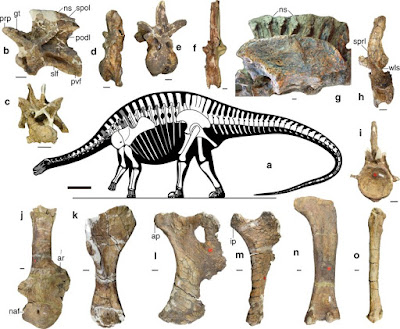[Most Recent Entries] [Calendar View]
Wednesday, July 25th, 2018
| Time | Event | ||||
| 2:37p | [Paleontology • 2018] Lingwulong shenqi • A New Middle Jurassic Diplodocoid Suggests An Earlier Dispersal and Diversification of Sauropod Dinosaurs
Abstract The fragmentation of the supercontinent Pangaea has been suggested to have had a profound impact on Mesozoic terrestrial vertebrate distributions. One current paradigm is that geographic isolation produced an endemic biota in East Asia during the Jurassic, while simultaneously preventing diplodocoid sauropod dinosaurs and several other tetrapod groups from reaching this region. Here we report the discovery of the earliest diplodocoid, and the first from East Asia, to our knowledge, based on fossil material comprising multiple individuals and most parts of the skeleton of an early Middle Jurassic dicraeosaurid. The new discovery challenges conventional biogeographical ideas, and suggests that dispersal into East Asia occurred much earlier than expected. Moreover, the age of this new taxon indicates that many advanced sauropod lineages originated at least 15 million years earlier than previously realised, achieving a global distribution while Pangaea was still a coherent landmass. Systematic paleontology Sauropoda Marsh, 1878 Neosauropoda Bonaparte, 1986 Diplodocoidea (Marsh, 1884) Dicraeosauridae Janensch, 1929 Lingwulong shenqi gen. et sp. nov. Etymology: Lingwu, after the region where the specimens were found; long, the Mandarin Chinese for ‘dragon’; and shenqi, the Mandarin Chinese for ‘amazing’, reflecting the unexpected discovery of a dicraeosaurid in the Middle Jurassic of China. Horizon and locality: Yanan Formation, late Early to early Middle Jurassic (late Toarcian–Bajocian), Lingwu Geopark, near Ciyaopu, Ningxia Hui Autonomous Region, China. Diagnosis: Autapomorphies: prefrontal anterior process directed laterally; orbital dorsal margin strongly ornamented by deep, longitudinal grooves and tubercles; long-axes of the free tips of the basal tubera directed anteromedially; capitate process mediolaterally long (length:height ratio c. 5.0); occipital condyle articular surface wide transversely (width:height ratio c. 1.54); lateral surface of cervical prezygapophyseal process bears a ridge formed by a linear array of tubercles; subcircular facet-like region at the summit of metapophyses in middle cervical-anterior dorsal vertebrae; small process projects anterodorsally from the anterior margin of the transverse process, near its distal end, in anterior dorsal vertebrae; anterior dorsal metapophyses twisted along their length; anterior caudal neural spines bear subtriangular facet-like areas, extending from summit to spine mid-height.
Xing Xu, Paul Upchurch, Philip D. Mannion, Paul M. Barrett, Omar R. Regalado-Fernandez, Jinyou Mo, Jinfu Ma and Hongan Liu. 2018. A New Middle Jurassic Diplodocoid Suggests An Earlier Dispersal and Diversification of Sauropod Dinosaurs. Nature Communications. 9, 2700. DOI: 10.1038/s41467-018-05128-1 'Amazing Dragon' Fossil Upends Origins of World's Largest Dinosaurs on.natgeo.com/2JQPINr @NatGeoScience | ||||
| 3:01p | [Herpetology • 2018] Hypogeophis montanus • A New Species of Small, Long-snouted Hypogeophis Peters, 1880 (Gymnophiona: Indotyphlidae) from the Highest Elevations of the Seychelles Island of Mahé
Abstract A new species of indotyphlid caecilian amphibian, Hypogeophis montanus sp. nov., is described based on a series of specimens from the Seychelles island of Mahé, collected from two localities in 2013 and 2015. The new species most closely resembles the Seychelles (Mahé) endemic H. brevis in being short (maximum known total length in life ca. 110 mm) and long snouted, but differs by having more vertebrae, a relatively smaller head, and substantially distinct mitochondrial and nuclear gene sequences. Hypogeophis montanus sp. nov. is known from higher elevations (718–731 m) than H. brevis (ca. 350–650 m), and its elevationally restricted distribution on a single small island likely renders it threatened under IUCN Red List criteria. Hypogeophis montanus sp. nov. is the third species of small and long-snouted caecilian reported from the Seychelles. Along with H. brevis and H. pti, H. montanus sp. nov. is among the smallest known species of caecilian and possibly has the smallest global distribution. Keywords: Amphibia, herpetology, Hypogeophis brevis, Hypogeophis pti, Indian Ocean, Morne Seychellois, systematics, taxonomy
Hypogeophis montanus sp. nov. Etymology. The specific epithet is in reference to the restricted, high elevation distribution of the species, known only from above 700 m, on the highest mountains in the Seychelles. For nomenclatural purposes the specific epithet is considered to be a noun in apposition. Suggested ‘common’ names. Montane Mahé caecilian; montane hypogeophis (English), leverdter nwanr montanny (Creole). Simon T. Maddock, Mark Wilkinson and David J. Gower. 2018. A New Species of Small, Long-snouted Hypogeophis Peters, 1880 (Amphibia: Gymnophiona: Indotyphlidae) from the Highest Elevations of the Seychelles Island of Mahé. Zootaxa. 4450(3); 359–375. DOI: 10.11646/zootaxa.4450.3.3 |
| << Previous Day |
2018/07/25 [Calendar] |
Next Day >> |











